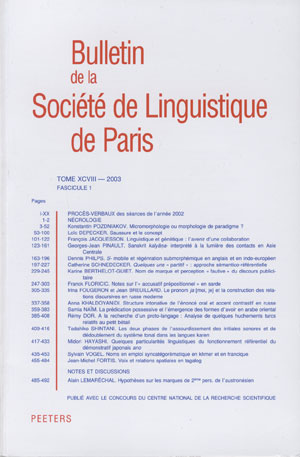 previous article in this issue previous article in this issue | next article in this issue  |

Preview first page |
Document Details : Title: Autour de la pseudo-coordination Subtitle: Réflexions comparatives sur le grec ancien et le latin Author(s): TRONCI, Liana Journal: Bulletin de la Société de Linguistique de Paris Volume: 116 Issue: 1 Date: 2021 Pages: 125-160 DOI: 10.2143/BSL.116.1.3290234 Abstract : Cette étude porte sur deux types de constructions multi-verbales du grec ancien qui, malgré leurs différences syntaxiques, sont fonctionnellement équivalentes. Dans le premier type (construction pseudo-coordonnée), les deux verbes sont conjugués au même mode et liés par un coordonnant ou par l’asyndète; dans le second, le premier verbe est un participe. Nous analysons les propriétés sémantiques, syntaxiques et textuelles des deux types dans un corpus constitué des quatre Évangiles. Nous montrons que le contact avec l’hébreu biblique et l’araméen a joué un rôle dans la diffusion de ces constructions. L’analyse des traductions latines dans la Vulgate nous amène à proposer des considérations supplémentaires sur la syntaxe des deux langues. This study deals with two types of Ancient Greek multi-verbal constructions, which are syntactically different but functionally equivalent. In the first one (pseudo-coordinated construction), two verbs are inflected in the same mood and linked by the coordinator ‘and’ or juxtaposed without any linker; in the second one, the first verb is a participle and is contiguous to the second verb. We analyse the syntactic and semantic properties of the two types and their textual distribution in the four Gospels. We show that contact with Biblical Hebrew and Aramaic played an important role in the genesis and spread of these constructions. By analysing the translation of the Gospels into Latin (with reference to the Vulgate text), we also offer some comparative remarks on the syntax of the two languages. |
|


